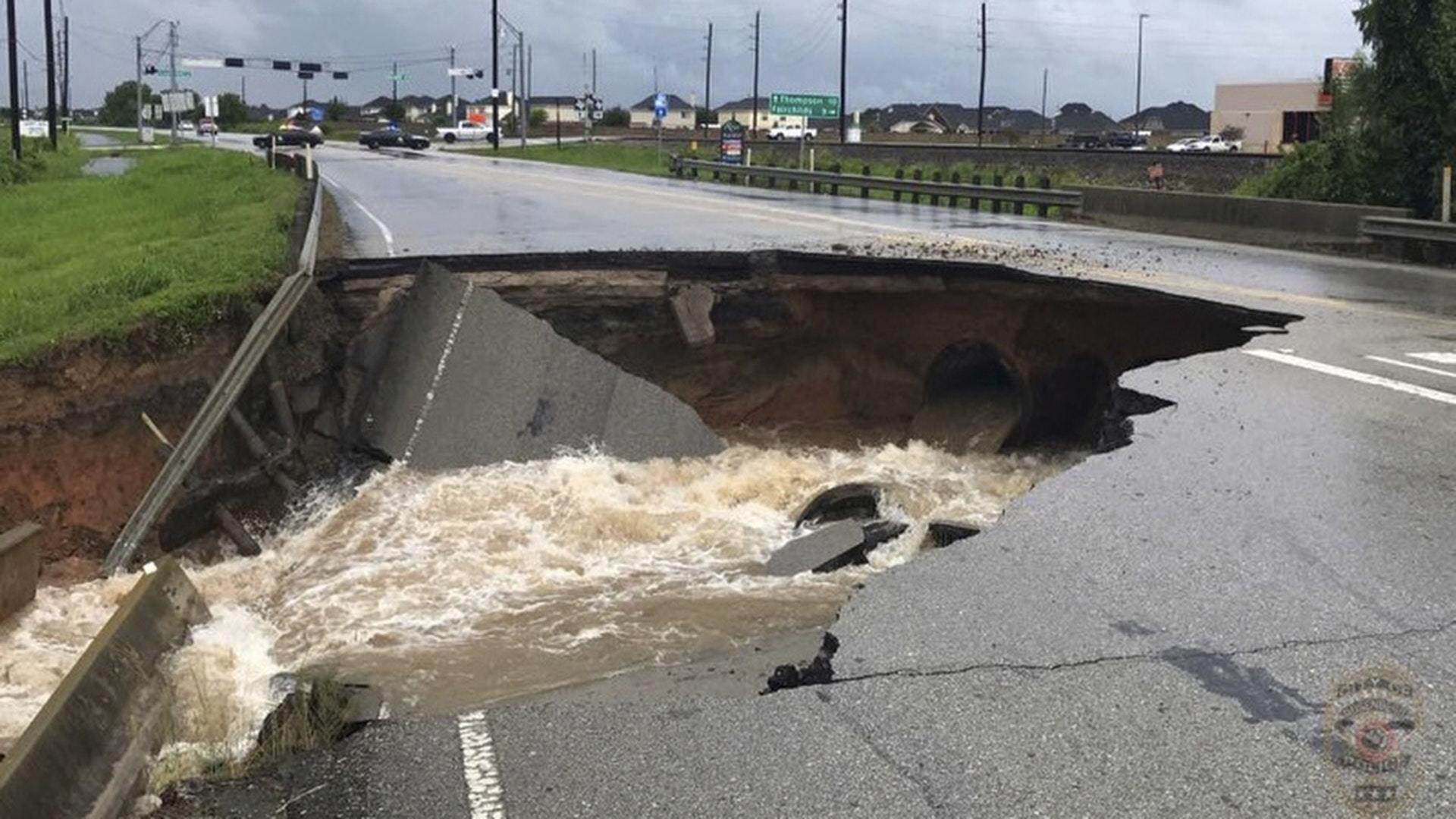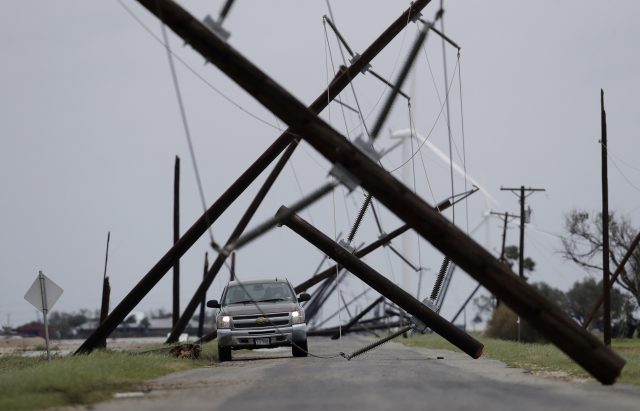
The remnants of Hurricane Harvey sent devastating floods pouring into Houston on Sunday as rising water left thousands stranded and overwhelmed rescuers.
Helicopters, boats and high-water vehicles swarmed around inundated areas, pulling people from their homes or from the turbid water, which was high enough in some places to gush into second floors.
As the extent of the flooding emerged, President Donald Trump announced he will travel to Texas on Tuesday.
I will be going to Texas as soon as that trip can be made without causing disruption. The focus must be life and safety.
— Donald J. Trump (@realDonaldTrump) August 27, 2017
White House press secretary Sarah Huckabee Sanders tolds reporters the White House is still coordinating logistics with state and local officials.
She added: “We continue to keep all of those affected in our thoughts and prayers.”
The flooding from the tropical storm was so widespread that authorities had trouble pinpointing the worst areas.
They urged people to get on top of their homes to avoid becoming trapped in attics and to wave sheets or towels to draw attention to their location.
Going to a Cabinet Meeting (tele-conference) at 11:00 A.M. on #Harvey. Even experts have said they've never seen one like this!
— Donald J. Trump (@realDonaldTrump) August 27, 2017
As floodwaters rose, the National Weather Service offered another ominous forecast:
Before the storm passes, some parts of Houston and its suburbs could receive as much as 50 inches of rain. That would be the highest amount ever recorded in Texas.
“The breadth and intensity of this rainfall is beyond anything experienced before,” the National Weather Service said in a statement.
Average rainfall totals will end up around 40 inches for Houston, weather service meteorologist Patrick Burke said.
Going to a Cabinet Meeting (tele-conference) at 11:00 A.M. on #Harvey. Even experts have said they've never seen one like this! — Donald J. Trump (@realDonaldTrump) August 27, 2017
“This disaster’s going to be a landmark event,” Mr Long said.
Rescuers had to give top priority to life-and-death situations, leaving many displaced families to fend for themselves. The city’s main convention centre was quickly opened as a shelter.
Harris County Sheriff Ed Gonzalez used Twitter to field calls for assistance. Among those seeking help was a woman who posted: “I have 2 children with me and the water is swallowing us up.”
Major rescue operations underway! — Donald J. Trump (@realDonaldTrump) August 27, 2017
Others waded while carrying rubbish bags stuffed with their belongings and small animals in pet carriers.
Houston Mayor Sylvester Turner said authorities had received more than 2,000 calls for help, with more coming in.
He urged drivers to stay off flooded roads to avoid adding to the number of those stranded.
Wow – Now experts are calling #Harvey a once in 500 year flood! We have an all out effort going, and going well! — Donald J. Trump (@realDonaldTrump) August 27, 2017
“We have several hundred structural flooding reports. We expect that number to rise pretty dramatically.”
The mayor defended his decision not to ask residents to evacuate before the heavy rain from Harvey swamped roads and neighbourhoods.
He said there was no way to know which areas were most vulnerable.

“If you think the situation right now is bad, and you give an order to evacuate, you are creating a nightmare,” he said, citing the risks of sending the city’s 2.3 million inhabitants onto the roads at the same time.
Texas Governor Greg Abbott announced the state had activated 3,000 National Guard and State Guard members to cope with the flooding, along with 500 vehicles and 14 aircraft.
And as a sinkhole opened on a road about 25 miles (40 kilometres) south west of Houston, Mr Abbott revealed there were now 250 road closures around Texas.
Tornado threat expected to continue across parts of SE Texas and far SW Louisiana @NWSSPC https://t.co/k050eeWjE5 #Harvey pic.twitter.com/qwp9QUUy3c — NHC Atlantic Ops (@NHC_Atlantic) August 27, 2017
The Coast Guard, which received more than 300 requests for help, deployed five helicopters and asked for additional aircraft from New Orleans.
Staff at a Houston television station broadcasting live coverage of the floods had to evacuate after water started to gush into the building.
The anchors and news operations at KHOU moved first to a second
Going to a Cabinet Meeting (tele-conference) at 11:00 A.M. on #Harvey. Even experts have said they've never seen one like this!
— Donald J. Trump (@realDonaldTrump) August 27, 2017
As floodwaters rose, the National Weather Service offered another ominous forecast:
Before the storm passes, some parts of Houston and its suburbs could receive as much as 50 inches of rain. That would be the highest amount ever recorded in Texas.
“The breadth and intensity of this rainfall is beyond anything experienced before,” the National Weather Service said in a statement.
Average rainfall totals will end up around 40 inches for Houston, weather service meteorologist Patrick Burke said.
Going to a Cabinet Meeting (tele-conference) at 11:00 A.M. on #Harvey. Even experts have said they've never seen one like this! — Donald J. Trump (@realDonaldTrump) August 27, 2017
“This disaster’s going to be a landmark event,” Mr Long said.
Rescuers had to give top priority to life-and-death situations, leaving many displaced families to fend for themselves. The city’s main convention centre was quickly opened as a shelter.
Harris County Sheriff Ed Gonzalez used Twitter to field calls for assistance. Among those seeking help was a woman who posted: “I have 2 children with me and the water is swallowing us up.”
Major rescue operations underway!
— Donald J. Trump (@realDonaldTrump) August 27, 2017
Some people used inflatable beach toys, rubber rafts and even air mattresses to get through the water to safety.
Others waded while carrying rubbish bags stuffed with their belongings and small animals in pet carriers.
Houston Mayor Sylvester Turner said authorities had received more than 2,000 calls for help, with more coming in.
He urged drivers to stay off flooded roads to avoid adding to the number of those stranded.
Wow – Now experts are calling #Harvey a once in 500 year flood! We have an all out effort going, and going well!
— Donald J. Trump (@realDonaldTrump) August 27, 2017
“I don’t need to tell anyone this is a very, very serious and unprecedented storm,” Mr Turner told a news conference.
“We have several hundred structural flooding reports. We expect that number to rise pretty dramatically.”
The mayor defended his decision not to ask residents to evacuate before the heavy rain from Harvey swamped roads and neighbourhoods.
He said there was no way to know which areas were most vulnerable.

“If you think the situation right now is bad, and you give an order to evacuate, you are creating a nightmare,” he said, citing the risks of sending the city’s 2.3 million inhabitants onto the roads at the same time.
Texas Governor Greg Abbott announced the state had activated 3,000 National Guard and State Guard members to cope with the flooding, along with 500 vehicles and 14 aircraft.
And as a sinkhole opened on a road about 25 miles (40 kilometres) south west of Houston, Mr Abbott revealed there were now 250 road closures around Texas.
Tornado threat expected to continue across parts of SE Texas and far SW Louisiana @NWSSPC https://t.co/k050eeWjE5 #Harvey pic.twitter.com/qwp9QUUy3c
— NHC Atlantic Ops (@NHC_Atlantic) August 27, 2017
Rainfall of more than four inches per hour resulted in water levels higher than in any recent floods and higher than during Tropical Storm Allison in June 2001, said Jeff Linder of flood control district in Harris County, which includes Houston.
The Coast Guard, which received more than 300 requests for help, deployed five helicopters and asked for additional aircraft from New Orleans.
Staff at a Houston television station broadcasting live coverage of the floods had to evacuate after water started to gush into the building.
The anchors and news operations at KHOU moved first to a second floor before finally abandoning the station.

Enjoy the convenience of having The Sunday Post delivered as a digital ePaper straight to your smartphone, tablet or computer.
Subscribe for only £5.49 a month and enjoy all the benefits of the printed paper as a digital replica.
Subscribe